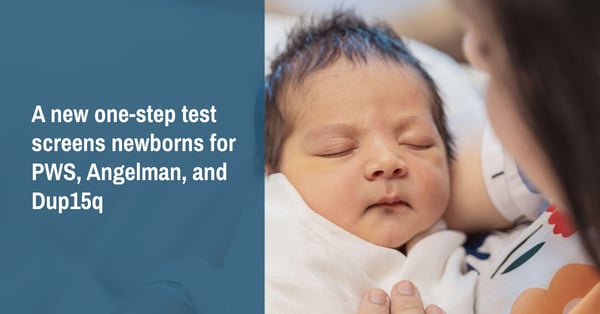Research at a Glance:
- A new test, funded in part by FPWR, has been designed to simultaneously screen newborns for three rare genetic disorders
- In a recent study, the test was found to be feasible, reliable, and scalable
- Screening for Prader Willi, Angelman, and Dup15q syndromes using the new test could open new avenues for earlier diagnosis and treatment, paving the way for the three disorders to be added to newborn bloodspot screening programs (heel prick test) for the first time
- The cost, disorder prevalence, and performance of the test were in line with other conditions currently included in newborn screening programs
 A newly developed test to screen for three rare genetic disorders simultaneously in newborns was feasible, reliable, and scalable, according to a new study.
A newly developed test to screen for three rare genetic disorders simultaneously in newborns was feasible, reliable, and scalable, according to a new study.
The research, led by the Murdoch Children’s Research Institute (MCRI), reported that screening for Prader Willi, Angelman and Dup15q syndromes using the new type of test would open new avenues for earlier diagnosis and treatment, paving the way for the three chromosome 15 imprinting disorders to be added to newborn bloodspot screening programs (heel prick test) for the first time.
The study, published in The Journal of the American Medical Association Network Open, was the first to validate the use of a low-cost, specialized screening method called Methylation Specific-Quantitative Melt Analysis (MS-QMA), developed by MCRI researchers, for these disorders at a large scale.
The one-step test can be used to screen for the three conditions simultaneously, by looking at the number of chemical modifications or marks called methylation added to affected genes, which are not present at such high or low levels in children without these disorders.
The study first checked for accuracy, with the test correctly distinguishing most of the 167 samples from people who had one of the disorders. It was then tested on 16,579 newborns in Victoria with the test identifying two with Prader Willi, two with Angelman, and one with Dup15q.
MCRI Associate Professor David Godler said a key reason why these disorders were not included in current programs was the lack of a test with low laboratory costs that could work at a population scale.
“Tests are currently only performed on those suspected of having these disorders, and only if features are recognized by a child’s doctor, and subsequently referred for appropriate testing,” he said. “This is not the case with newborn screening where testing is performed on all newborns before symptoms become apparent.”
Associate Professor Godler said the study found the cost, disorder prevalence and accuracy of MS-QMA as a first- tier test were in line with other conditions currently included in newborn screening programs.
The study reported that in the 16,579 newborns screened, the probability of those with a positive screening test truly having the disease using MS-QMA was 67 percent, 33 percent and 44 percent for Angelman, Prader Willi, and combined detection of chromosome 15 imprinting disorders, respectively. Babies who screen positive for a disorder will then undergo additional testing to confirm the diagnosis.
“Having a high positive predictive value is important for newborn screening as it ensures that there is a lower number of false-positive results that need to be repeated, leading to lower overall laboratory costs, less work for maternity services in obtaining a repeated blood sample, and minimizes the psychological effect on families,” Associate Professor Godler said.
MCRI Professor David Amor said that if these findings were replicated in future independent studies, adding these chromosome 15 imprinting disorders to newborn screening programs would allow for earlier diagnosis and using targeted interventions as they emerge, such as gene therapy for Angelman syndrome.
"For Prader-Willi syndrome, diagnosis in infancy allows for early initiation of growth hormone treatment to improve long-term health outcomes," he said. "For Angelman and Dupe15q, most infants do not receive an early diagnosis that would allow intervention in the first year of life. But such early diagnosis, if available through newborn screening, could prevent the diagnostic odyssey, reduce medical costs, and the significant stress and anxiety currently experienced by the families while they await a diagnosis.








